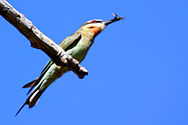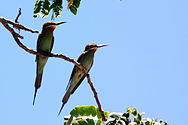Olive bee-eater
| Olive bee-eater | |
|---|---|

| |
| Scientific classification | |
| Kingdom: | |
| Phylum: | |
| Class: | |
| Order: | |
| Family: | |
| Genus: | |
| Species: | M. superciliosus
|
| Binomial name | |
| Merops superciliosus Linnaeus, 1766
| |
The olive bee-eater, (or Madagascar bee-eater) (Merops superciliosus) is a near passerine bee-eater species in the genus Merops. It is native to the southern half of Africa where it is present in Angola; Botswana; Burundi; Comoros; Democratic Republic of the Congo; Djibouti; Eritrea; Ethiopia; Kenya; Madagascar; Malawi; Mayotte; Mozambique; Namibia; Rwanda; Somalia; South Sudan; Sudan; Tanzania; Uganda; Zambia; Zimbabwe. It is a common species with a wide range so the International Union for Conservation of Nature has rated their conservation status as "least concern".[1]
Description
The olive bee-eater grows to a length of 23 to 26 cm (9.1 to 10.2 in) with its tail streamers adding up to 7 cm (2.8 in). The sexes are similar, and adults have bronzy-green plumage with an olive cap and white forehead, eyebrows, chin and cheeks. The rump and tail are blue, apart from the streamers, which are black.[2]
Distribution
The olive bee-eater is found in the grassland and coastal mountain forests of East Africa and Madagascar, and an isolated population can be found in coastal Angola.[3] There are two subspecies; M. s. superciliosus occurs in eastern Ethiopia, Somalia and Kenya, and southwards through East Africa to southern Mozambique and the Zambezi Valley, as well as the Comoro Islands and Madagascar; M. s. alternans occurs in western Angola and northwestern Namibia.[4]
Ecology
They are partially migratory, and usually breed only in the southern portion of their range, moving north for the dry season in southern Africa. It lays four eggs in a burrow nest at the beginning of the southern African wet season, and the chicks usually hatch at the beginning of December.[5] Unlike most bee-eaters, the species does not practice cooperative breeding and post-fledging dependence is only around nineteen days, which is typical of temperate zone passerines and about half that of most Meropidae species.[6]
Gallery
-
A bee caught in the Anjajavy Forest
-
Pair in the Anjajavy Forest
-
In flight over a swimming pool at Anjajavy
References
- ^ a b Template:IUCN
- ^ Fry, C. Hilary; Fry, Kathie (2010). Kingfishers, Bee-eaters and Rollers. Bloomsbury Publishing. p. 273. ISBN 978-1-4081-3525-9.
- ^ "Range map". IUCN. Retrieved 16 October 2016.
- ^ Fry, H.; Boesman, P. (2016). "Olive Bee-eater (Merops superciliosus)". Handbook of the Birds of the World Alive. Lynx Edicions, Barcelona. Retrieved 16 October 2016.
- ^ "Madagascar Bee-eater, Olive Bee-eater". Biodiversity Explorer. Iziko. Retrieved 16 October 2016.
- ^ Langen, Tom A. (2000). "Prolonged offspring dependence and cooperative breeding in birds". Behavioral Ecology. 11 (4): 367–377. doi:10.1093/beheco/11.4.367.
External links
- Olive bee-eater - Species text in The Atlas of Southern African Birds.




